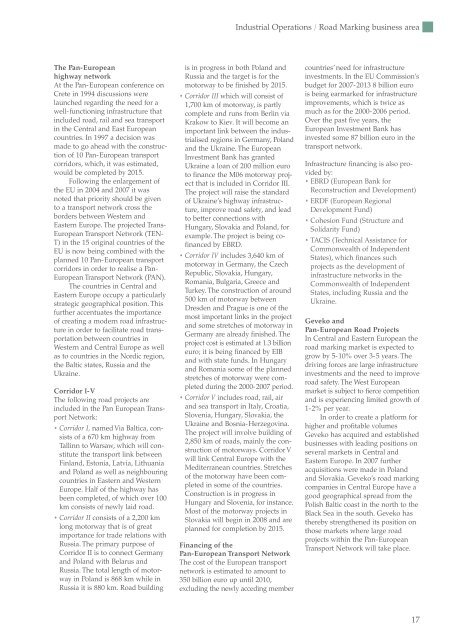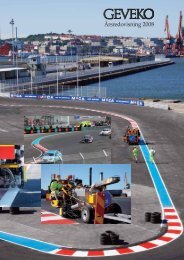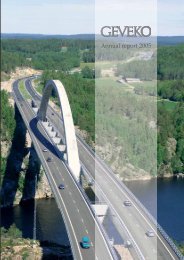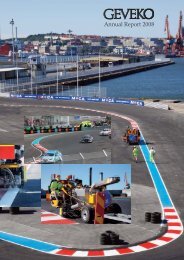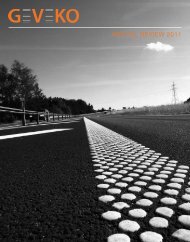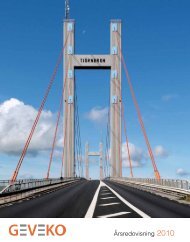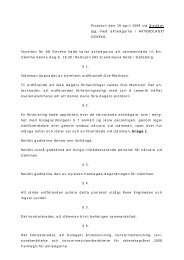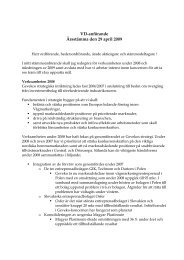PDF Document 2.46 MB - Geveko
PDF Document 2.46 MB - Geveko
PDF Document 2.46 MB - Geveko
Create successful ePaper yourself
Turn your PDF publications into a flip-book with our unique Google optimized e-Paper software.
Industrial Operations / Road Marking business areaThe Pan-Europeanhighway networkAt the Pan-European conference onCrete in 1994 discussions werelaunched regarding the need for awell-functioning infrastructure thatincluded road, rail and sea transportin the Central and East Europeancountries. In 1997 a decision wasmade to go ahead with the constructionof 10 Pan-European transportcorridors, which, it was estimated,would be completed by 2015.Following the enlargement ofthe EU in 2004 and 2007 it wasnoted that priority should be givento a transport network cross theborders between Western andEastern Europe. The projected Trans-European Transport Network (TEN-T) in the 15 original countries of theEU is now being combined with theplanned 10 Pan-European transportcorridors in order to realise a Pan-European Transport Network (PAN).The countries in Central andEastern Europe occupy a particularlystrategic geographical position. Thisfurther accentuates the importanceof creating a modern road infrastructurein order to facilitate road transportationbetween countries inWestern and Central Europe as wellas to countries in the Nordic region,the Baltic states, Russia and theUkraine.Corridor I-VThe following road projects areincluded in the Pan European Trans -port Network:• Corridor I, named Via Baltica, consistsof a 670 km highway fromTallinn to Warsaw, which will constitutethe transport link betweenFinland, Estonia, Latvia, Lithuaniaand Poland as well as neighbouringcountries in Eastern and WesternEurope. Half of the highway hasbeen completed, of which over 100km consists of newly laid road.• Corridor II consists of a 2,200 kmlong motorway that is of greatimportance for trade relations withRussia. The primary purpose ofCorridor II is to connect Germanyand Poland with Belarus andRussia. The total length of motorwayin Poland is 868 km while inRussia it is 880 km. Road buildingis in progress in both Poland andRussia and the target is for themotorway to be finished by 2015.• Corridor III which will consist of1,700 km of motorway, is partlycomplete and runs from Berlin viaKrakow to Kiev. It will become animportant link between the industrialisedregions in Germany, Polandand the Ukraine. The EuropeanInvestment Bank has grantedUkraine a loan of 200 million euroto finance the M06 motorway projectthat is included in Corridor III.The project will raise the standardof Ukraine’s highway infrastructure,improve road safety, and leadto better connections withHungary, Slovakia and Poland, forexample. The project is being cofinancedby EBRD.• Corridor IV includes 3,640 km ofmotorway in Germany, the CzechRepublic, Slovakia, Hungary,Romania, Bulgaria, Greece andTurkey. The construction of around500 km of motorway betweenDresden and Prague is one of themost important links in the projectand some stretches of motorway inGermany are already finished. Theproject cost is estimated at 1.3 billioneuro; it is being financed by EIBand with state funds. In Hungaryand Romania some of the plannedstretches of motorway were completedduring the 2000-2007 period.• Corridor V includes road, rail, airand sea transport in Italy, Croatia,Slovenia, Hungary, Slovakia, theUkraine and Bosnia-Herzegovina.The project will involve building of2,850 km of roads, mainly the constructionof motorways. Corridor Vwill link Central Europe with theMediterranean countries. Stretchesof the motorway have been completedin some of the countries.Construction is in progress inHungary and Slovenia, for instance.Most of the motorway projects inSlovakia will begin in 2008 and areplanned for completion by 2015.Financing of thePan-European Transport NetworkThe cost of the European transportnetwork is estimated to amount to350 billion euro up until 2010,ex cluding the newly acceding membercountries’ need for infrastructureinvestments. In the EU Commission’sbudget for 2007-2013 8 billion eurois being earmarked for infrastructureimprovements, which is twice asmuch as for the 2000-2006 period.Over the past five years, theEuropean Investment Bank hasinvested some 87 billion euro in thetransport network.Infrastructure financing is also providedby:• EBRD (European Bank forReconstruction and Development)• ERDF (European RegionalDevelopment Fund)• Cohesion Fund (Structure andSolidarity Fund)• TACIS (Technical Assistance forCommonwealth of IndependentStates), which finances suchprojects as the development ofinfrastructure networks in theCommon wealth of IndependentStates, including Russia and theUkraine.<strong>Geveko</strong> andPan-European Road ProjectsIn Central and Eastern European theroad marking market is expected togrow by 5-10% over 3-5 years. Thedriving forces are large infrastructureinvestments and the need to im proveroad safety. The West Europeanmarket is subject to fierce competitionand is experiencing limited growth of1-2% per year.In order to create a platform forhigher and profitable volumes<strong>Geveko</strong> has acquired and establishedbusinesses with leading positions onseveral markets in Central andEastern Europe. In 2007 furtheracquisitions were made in Polandand Slovakia. <strong>Geveko</strong>’s road markingcompanies in Central Europe have agood geographical spread from thePolish Baltic coast in the north to theBlack Sea in the south. <strong>Geveko</strong> hasthereby strengthened its position onthose markets where large roadprojects within the Pan-EuropeanTransport Network will take place.17


